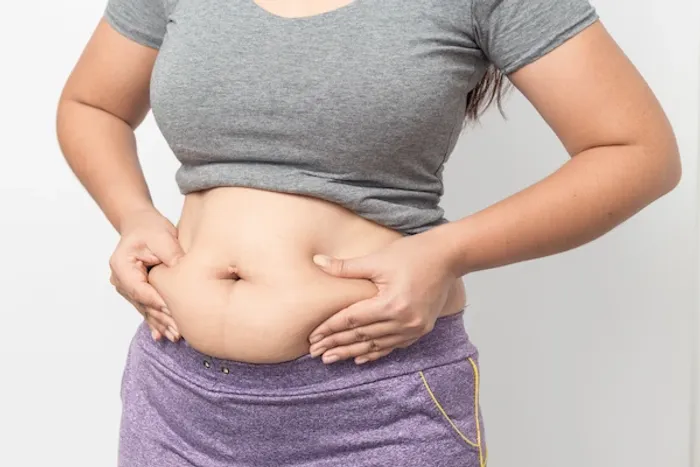Belly Fat Types And Risks: Your Complete Guide
Learn about the types of belly fat, associated health risks, measurement methods, diet, exercise, and lifestyle strategies to reduce visceral fat safely and effectively.


Introduction
Belly fat isn’t just about appearance—it’s about health. Not all fat is the same, and where your body stores it matters. Two types of belly fat play very different roles: the soft layer under your skin and the deeper fat that wraps around organs. The second type is strongly linked to higher health risks, from heart disease and diabetes to fatty liver and some cancers. The good news? With the right measuring tools, smart food choices, and targeted activity, you can reduce risky fat and lower your long-term risks.
In this guide, we’ll unpack the types of belly fat and the risks they carry, show you how to measure your belly fat at home, explain why some people are more prone to central fat gain, and share practical steps to reduce it—without crash diets or complicated routines. You’ll learn what works, why it works, and how to tailor strategies to your life stage. We’ll also cover tests worth considering, when to seek medical support, and how to track progress. Let’s make your next steps clear and doable.
What This Guide Covers and Who It’s For
Here's what this guide provides:
This guide is for anyone who wants a science-based, step-by-step plan to reduce belly fat and health risks. You’ll find:
- Clear definitions of subcutaneous and visceral fat, and why visceral fat is riskier.
- Simple, accurate methods to measure belly fat, including ethnic-specific waist cut-offs.
- The key risks tied to abdominal fat—heart, metabolic, liver, and certain cancers.
- What drives belly fat gain and what actually reduces it.
- Scalable food and exercise strategies, from beginner-friendly to advanced.
- When to consider medical support, relevant lab tests, and how telehealth can help.
Consult Top Specialists
Belly Fat Basics
Here's a breakdown of belly fat types and anatomy:
Subcutaneous vs Visceral Fat: The Two Main Types
- Subcutaneous fat sits just under your skin—you can pinch it.
- Visceral fat packs around your organs (liver, intestines), deep inside the abdomen. You can’t pinch it, but it often shows up as a firm, protruding belly.
Subcutaneous fat cushions and stores energy. Visceral fat, however, is metabolically active, releasing inflammatory molecules and hormones that can disrupt blood sugar, blood pressure, and cholesterol regulation. This is why two people with the same weight can have very different risks—depending on their fat type and distribution.
Why Visceral Fat Raises Health Risks
Visceral fat:
- Bathes the liver in free fatty acids, promoting insulin resistance and fatty liver.
- Secretes cytokines and adipokines that stoke chronic inflammation and arterial plaque formation.
Is strongly associated with type 2 diabetes, high triglycerides, low HDL, and hypertension.
These processes collectively increase risks for heart disease, stroke, certain cancers (e.g., colorectal, postmenopausal breast), and possibly cognitive decline.
Where Belly Fat Sits: A Quick Anatomy Tour
Your “core” region includes subcutaneous fat at the surface, abdominal muscles beneath, then deep visceral fat surrounding organs. You can be relatively lean on the outside but still carry high visceral fat (TOFI—thin outside, fat inside). That’s why measuring waist and ratios offers a truer risk picture than body weight alone.
How to Measure Belly Fat at Home
Here's how to track abdominal fat at home:
Waist Circumference (How-To + Cut-Offs by Sex and Ethnicity)
How to measure:
Stand relaxed. Place a soft tape at the midpoint between your lowest rib and the top of your hip bone (iliac crest), usually at the level of the navel. Exhale gently and measure without compressing the skin.
General risk cut-offs:
- Men: ≥102 cm (40 in) suggests higher risks.
- Women: ≥88 cm (35 in) suggests higher risks.
Ethnicity matters. Many Asian populations have higher risk at lower waist sizes: - Asian men: ≥90 cm (35 in)
- Asian women: ≥80 cm (31.5 in)
Waist-to-Hip Ratio and Waist-to-Height Ratio
- Waist-to-hip ratio (WHR) = waist ÷ hip. Increased risk above ~0.90 for men and ~0.85 for women.
- Waist-to-height ratio (WtHR) = waist ÷ height. Keep waist less than half your height (<0.5).
BMI vs Belly Fat: Why Both Matter
BMI is a population-level tool that doesn’t capture fat distribution. Two people with the same BMI may have very different risks if one stores more visceral fat. Combining BMI with waist measures gives the best at-home snapshot.
When to Consider Imaging (DEXA, MRI)
If you need more detail—e.g., athletic individuals, or when waist measures and BMI disagree—DEXA scans estimate total and regional fat; MRI quantifies visceral adipose tissue. These are not routine but can help in complex cases or research settings.
Health Risks Linked to Belly Fat
Here's why abdominal fat matters:
Heart and Metabolic Risks (Diabetes, Cholesterol, Hypertension)
Visceral fat promotes insulin resistance, raising blood sugar and HbA1c; elevates triglycerides; lowers HDL; and contributes to higher blood pressure. Collectively, these form metabolic syndrome, which significantly increases the risk of heart attack and stroke. Large population studies show that larger waists are linked to higher cardiometabolic events and mortality, independent of BMI.
Fatty Liver and Inflammation
Excess visceral fat drives nonalcoholic fatty liver disease (NAFLD). Over time, NAFLD can progress to nonalcoholic steatohepatitis (NASH), fibrosis, and cirrhosis. Reducing visceral fat, improving insulin sensitivity, and limiting sugary drinks and alcohol can meaningfully lower liver fat.
Cancers and Cognitive Risks
Abdominal obesity is associated with higher risks of colorectal cancer, postmenopausal breast cancer, endometrial cancer, and others—likely through inflammation, insulin/IGF-1 signalling, and sex hormone changes. Central adiposity has also been linked to cognitive decline and dementia risk in some studies.
What Drives Belly Fat Gain
Here's what contributes to abdominal fat accumulation:
Food Quality, Ultra-Processed Foods, and Liquid Calories
Diets high in ultra-processed foods, refined carbs, and sugary drinks spike insulin and make it easier to store visceral fat. Liquid calories, especially sugary beverages and excess alcohol, are strongly tied to abdominal fat gain. In contrast, whole foods with fibre and protein blunt glucose spikes, helping curb fat storage.
Stress, Cortisol, Sleep, and Shift Work
Chronic stress can elevate cortisol, nudging fat storage toward the abdomen. Irregular sleep and shift work disrupt circadian rhythms that govern hunger hormones (ghrelin/leptin), glucose regulation, and energy expenditure, increasing visceral fat over time. Targeting sleep (7–9 hours) and stress management is one of the highest-ROI interventions.
Hormones (Menopause, PCOS, Thyroid), Medications, and Genetics
- Menopause: Estrogen shifts promote central fat gain; strength training and adequate protein intake counter losses in muscle and metabolic rate.
- PCOS: Insulin resistance predisposes to abdominal fat; dietary strategies and strength training help improve sensitivity.
- Thyroid: Hypothyroidism can reduce metabolic rate, contributing to weight gain; treatment normalises metabolism but lifestyle still matters.
- Medications: Some antipsychotics, antidepressants, corticosteroids, and certain diabetes drugs can promote weight gain.
- Genetics: Family history and ethnic background influence fat distribution; lifestyle can still significantly modify risk.
Alcohol and “Beer Belly” Myths
It’s not just beer—any alcohol adds liquid calories and can preferentially increase abdominal fat by altering liver metabolism. Moderation is key.
Who’s at Higher Risk
Here's who may need extra attention:
Age, Sex, and Ethnicity Patterns
With age, muscle mass declines and insulin sensitivity drops, favouring central fat storage. Men tend to accumulate more visceral fat earlier; women see a shift after menopause. Many Asian, South Asian, Middle Eastern, and some Hispanic/Latino populations face higher risks at lower waist sizes and BMI.
Family History and Metabolic Syndrome
A family history of type 2 diabetes, hypertension, or early heart disease, plus increased waist size, compounds risk. If you have three or more of these—larger waist, high triglycerides, low HDL, elevated blood pressure, elevated fasting glucose—talk with your doctor about metabolic syndrome.
How to Reduce Belly Fat: Food Strategies That Work
Here's how diet can help:
Mediterranean-Style Pattern, Protein, and Fibre
A Mediterranean-style eating pattern—vegetables, fruits, legumes, whole grains, nuts, olive oil, fish—improves insulin sensitivity, lowers inflammation, and is linked with reductions in abdominal adiposity and cardiometabolic risk. Pairing each meal with protein (20–40 g for most adults) and fibre (8–12 g) blunts post-meal glucose and keeps you full longer.
Smart Carbs and Sugar Reduction Without Fads
Focus on quality carbs: oats, quinoa, legumes, root vegetables, and fruit. Reduce refined grains and added sugars, especially in drinks. A steady 300–500 calorie daily deficit with high-fibre, high-protein meals reliably reduces visceral fat over time.
Practical Meal and Snack Ideas
- Breakfast: Greek yogurt with berries, chia, and walnuts; or a veggie omelet with whole-grain toast.
- Lunch: Lentil salad with olive oil, feta, tomatoes, and cucumbers; or salmon with quinoa and greens.
- Dinner: Stir-fry tofu/chicken with mixed vegetables over brown rice; or chickpea and spinach curry.
- Snacks: Apple + peanut butter; roasted chickpeas; edamame; cottage cheese + pineapple.
How to Reduce Belly Fat: Exercise That Targets Risk
Here's how movement helps:
Cardio Basics (150–300 min/week) and HIIT
Aim for at least 150–300 minutes/week of moderate-intensity cardio (brisk walking, cycling, swimming) or 75–150 minutes/week of vigorous activity (running, cardio classes). High-Intensity Interval Training (HIIT) can be time-efficient and may preferentially reduce visceral fat in some studies.
Strength Training to Improve Insulin Sensitivity
Do full-body resistance training 2–3 days/week. Focus on squats, deadlifts, rows, presses, planks. Begin with bodyweight and bands; progress to weights as tolerated.
NEAT: The Underestimated Daily Movement
Non-exercise activity thermogenesis (NEAT)—steps, stair-climbing, standing breaks, housework, light cycling. Target 7,000–10,000 steps/day or add 2,000 steps to your baseline.
Weekly Mix-and-Match Workout Plans
- Beginner: 30 minutes brisk walking 5 days/week; two 20-minute full-body strength sessions; 5-minute movement breaks each hour.
- Intermediate: 3 x 40-minute moderate cardio; 1 x 20-minute HIIT; 2–3 strength sessions; 8,000–10,000 steps/day.
- Time-crunched: 3 x 20-minute HIIT/interval sessions; 2 x 30-minute strength; micro-walks after meals (10 minutes).
Lifestyle Levers with Outsized Impact
Here's what improves visceral fat reduction beyond food and exercise:
Sleep, Stress Tools, and Digital Hygiene
- Sleep 7–9 hours. Keep consistent sleep-wake times; limit screens 60 minutes before bed.
- Stress: Daily 5–10 minutes of breathing, mindfulness, or a short walk lowers cortisol and evening snacking.
- Digital hygiene: Silence notifications after 9 PM and charge the phone outside the bedroom.
Alcohol, Smoking, and Social Habits
- Alcohol: ≤1 drink/day for women, ≤2 for men; include alcohol-free days.
- Smoking cessation improves body composition and long-term cardiometabolic risk.
- Build “healthy defaults” with friends/family—walk-and-talks, cook-togethers, or active weekend plans.
Medical Support, Labs, and When to See a Doctor
Here's when to get professional support:
Useful Tests (HbA1c, Lipids, Liver Enzymes)
Ask about: HbA1c or fasting glucose, fasting lipid panel, liver enzymes, and blood pressure monitoring. Apollo 24|7 offers convenient home collection for labs.
Medications (e.g., GLP-1) and Surgical Options
GLP-1 receptor agonists (e.g., semaglutide) reduce weight and visceral fat; bariatric surgery is for severe obesity. Decisions should be individualised with your clinician.
Using Telehealth and Home Lab Collections
Persistent symptoms or lack of progress? Consult a doctor online with Apollo 24|7 for evaluation and a personalised plan.
Special Situations
Here's guidance for life stage or condition-specific needs:
Menopause and Midlife Weight Shift
Protein 1.2–1.6 g/kg/day, strength training 3x/week, adequate calcium/vitamin D, and sleep support metabolic rate and reduce abdominal fat.
PCOS and Insulin Resistance
Low-glycemic, high-fibre meals paired with strength training improve insulin sensitivity and menstrual regularity.
Postpartum Belly Fat and Core Recovery
Gentle walking and core rehab; avoid intense ab work if diastasis recti until cleared by a clinician.
Myths vs Facts
- Myth: “Spot-reduce belly fat with crunches.” Fact: Fat loss is systemic; core work builds strength.
- Myth: “Carbs always cause belly fat.” Fact: Quality and quantity matter.
- Myth: “Only long workouts work.” Fact: Short intervals and daily steps are effective.
- Myth: “Thin people don’t have visceral fat.” Fact: TOFI exists; waist measures matter.
Tracking Progress Without Obsessing
Here's how to monitor without stress:
Beyond the Scale: Tape, Photos, Strength, and Energy
Track waist circumference, progress photos, step counts, resting heart rate, and workout performance. Celebrate non-scale wins.
What Smart
- Scales Can and Can’t Tell You
- Bioimpedance scales estimate body fat, but readings vary. Use them for trends; tape measures and clothing fit are often more reliable.
Conclusion
Belly fat management starts with understanding fat types and the risks they pose. Visceral fat drives insulin resistance, inflammation, and higher risks of heart disease, diabetes, fatty liver, and certain cancers. You can lower those risks by measuring your waist, eating for stability, moving most days, and guarding sleep and stress. Layer habits to create a metabolic environment where your body steadily sheds visceral fat.
If your waist exceeds risk thresholds or you have other risk factors, ask your clinician about key labs and next steps. Some people may benefit from medical therapies or structured programs. If symptoms persist beyond two weeks or your condition doesn’t improve with these strategies, consult a doctor online with Apollo 24|7. Consistency beats perfection: start with one or two changes this week, build momentum, and let progress compound.
Consult Top Specialists
Consult Top Specialists

Dr Homeira Nishat
Obstetrician and Gynaecologist
34 Years • MBBS, Diploma in Obstetrics & Gynaecology
Bengaluru
Cure Hospital and Clinic, Bengaluru

Dr. Harshitha B R
Obstetrician and Gynaecologist
11 Years • MBBS, DGO( OBS & GYN)
Bengaluru
Apollo Clinic, JP nagar, Bengaluru

Dr. Humeena Taj C K
Obstetrician and Gynaecologist
11 Years • MBBS, DGO, DNB OBG
Bengaluru
Apollo Medical Center, Marathahalli, Bengaluru

Dr. Divyashree S
Obstetrician and Gynaecologist
7 Years • MBBS, MS (OBG)
Bengaluru
Apollo Clinic, JP nagar, Bengaluru

Dr. Sanjan Das
Obstetrician and Gynaecologist
15 Years • MBBS,MS
Bengaluru
Apollo Clinic, Sarjapur Road, Bengaluru
Consult Top Specialists

Dr Homeira Nishat
Obstetrician and Gynaecologist
34 Years • MBBS, Diploma in Obstetrics & Gynaecology
Bengaluru
Cure Hospital and Clinic, Bengaluru

Dr. Harshitha B R
Obstetrician and Gynaecologist
11 Years • MBBS, DGO( OBS & GYN)
Bengaluru
Apollo Clinic, JP nagar, Bengaluru

Dr. Humeena Taj C K
Obstetrician and Gynaecologist
11 Years • MBBS, DGO, DNB OBG
Bengaluru
Apollo Medical Center, Marathahalli, Bengaluru

Dr. Divyashree S
Obstetrician and Gynaecologist
7 Years • MBBS, MS (OBG)
Bengaluru
Apollo Clinic, JP nagar, Bengaluru

Dr. Sanjan Das
Obstetrician and Gynaecologist
15 Years • MBBS,MS
Bengaluru
Apollo Clinic, Sarjapur Road, Bengaluru
More articles from Weight Loss
Frequently Asked Questions
What’s the difference between subcutaneous fat vs visceral fat?
Subcutaneous fat sits under the skin; visceral fat surrounds organs. Visceral fat is more strongly linked to metabolic risks, including diabetes and heart disease.
How can I measure belly fat at home without special tools?
Use a soft tape measure at the navel/iliac crest line after a normal exhale. Track waist circumference, waist-to-hip ratio, and waist-to-height ratio; aim for a waist less than half your height.
How much exercise do I need to reduce visceral fat?
Aim for 150–300 minutes/week of moderate cardio (or 75–150 minutes vigorous), plus 2–3 strength sessions. Add daily steps and consider short HIIT for efficiency.
What diet reduces belly fat risks the most?
A Mediterranean-style pattern with lean protein, high fibre, healthy fats (olive oil, nuts), and limited added sugars and refined carbs supports visceral fat loss and better labs.
When should I see a doctor about belly fat and health risks?
If your waist is above risk cut-offs, you have symptoms (e.g., high blood pressure, fatigue, snoring), or family history of heart disease/diabetes, seek advice. Apollo 24|7 offers home lab collections and telehealth consultations.




